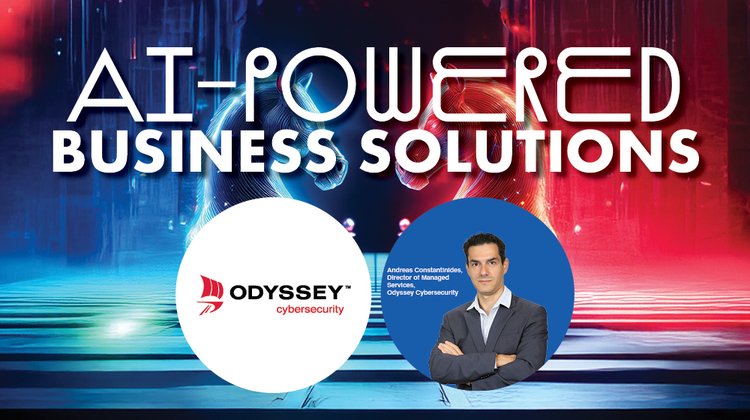Odyssey Cybersecurity: Cyber resilience redefined
10:26 - 28 April 2025

In cybersecurity, speed isn’t just technical—it’s strategic. By Andreas Constantinides, Director of Managed Services
The Clock is Ticking on Cyber Resilience
Across every industry, organizations are undergoing rapid digital transformation, integrating AI into customer experience, operations and decision-making. But as innovation accelerates, so does risk. Today’s cyber threat landscape is fast-moving, complex and increasingly intelligent. In this environment, resilience is no longer measured by whether an attack happens—but by how quickly and effectively an organization can detect and respond when it does.
This is where two key metrics come into focus: Mean Time to Detect (MTTD) and Mean Time to Respond (MTTR). Far from being buried in dashboards, these figures are fast becoming the language of resilience for both technical teams and the boardroom.
From Threat to Insight: The Power of MTTD
MTTD reflects the average time it takes for an organization to recognize that a threat exists. A low MTTD indicates strong visibility and proactive detection. A high MTTD, on the other hand, may indicate blind spots—providing adversaries with a dangerous head start.
Modern threats often use stealth tactics powered by AI, designed to mimic normal behaviour and slip past traditional defences. For Security Operations Centre (SOC) teams, this presents a growing challenge: how to distinguish genuine threats from the noise of false positives. Without intelligent prioritization and automation, analysts can find themselves chasing alerts rather than investigating real risks.
Organizations that empower their SOCs with AI-enabled visibility are discovering a powerful advantage: the ability to detect threats earlier, intercept intrusions mid-flight and significantly reduce attacker dwell time before significant damage occurs.
From Insight to Action: The Role of MTTR
MTTR reflects the average time an organization takes to contain and neutralize a threat after detection. In many cases, this metric reveals the difference between a minor incident and a business-critical breach.
Even rapid detection cannot compensate for delays in response caused by fragmented workflows, manual processes or overwhelmed teams. Such delays can lead to escalation, resulting in downtime, data loss, regulatory penalties and reputational harm.
Reducing MTTR requires more than just tools—it requires coordination, intelligence and a well-prepared team. Increasingly, organizations are adopting AI-powered managed security services that combine expert-led response with automated containment actions, enabling faster, more consistent mitigation across a broad range of attacks.
The Human-Machine Partnership at the Core of the SOC
Security Operations Centres (SOCs) stand at the frontlines of this transformation but face mounting pressures: talent shortages, rising alert volumes and growing expectations from leadership. To meet these demands, SOCs must evolve from reactive units to insight-driven teams empowered by AI.
AI-powered SOC services do not replace human judgment; they enhance it. By automating repetitive tasks, surfacing contextual intelligence instantly and accelerating every phase of the threat lifecycle, AI enables analysts to focus on strategic, high-value activities. From real-time enrichment of alerts to guided response recommendations, integrating AI into SOC operations shifts cybersecurity from reactive firefighting to proactive foresight.
From Metrics to Business Mandates
The relevance of MTTD and MTTR now extends beyond technical performance—they have become strategic indicators of operational readiness, regulatory compliance and enterprise agility.
For CISOs, CIOs, and Boards, these metrics provide tangible benchmarks to measure and communicate risk posture. They translate cybersecurity performance into the language of business: uptime, continuity, trust. They support better reporting, more accurate forecasting and more informed decision-making around risk investments.
When aligned with an AI-powered managed services model, organizations benefit from 24/7 expert coverage, real-time threat intelligence and continuously optimized detection and response capabilities—without bearing the complexity and cost of expanding internal teams.
AI as a Catalyst for Resilience
Artificial intelligence is not simply about automation—it’s about acceleration. Applied strategically, AI fundamentally transforms how organizations perceive and manage digital threats.
It identifies subtle anomalies that human analysts might overlook It converts overwhelming data noise into actionable clarity.
It empowers SOC teams and business leaders to act faster and with greater confidence—reducing time to insight, time to containment, and time to recovery.
Ultimately, this fusion of intelligent technology and expert human oversight offers a clear path forward: resilient, adaptive, and future-ready security.
Resilience Is the New Readiness
In an AI-powered world, the speed at which an organization detects and responds to cyber threats can make or break your ability to sustain trust, continuity and growth. MTTD and MTTR are no longer back-end metrics, they are front-and-centre indicators of organizational readiness and resilience.
By embracing AI-driven Managed Security Operations, businesses are moving beyond traditional, reactive defence strategies. They are adopting a resilience-first model—one that empowers their people, leverages the full potential of intelligent technologies and transforms cybersecurity into a strategic advantage.
Because in today’s landscape, resilience is no longer just about protecting systems. It’s about protecting everything they make possible.
CONTACT INFORMATION
e-mail: info@odysseycs.com
successmanager@mamacrm.com
Website: www.odysseycs.com
